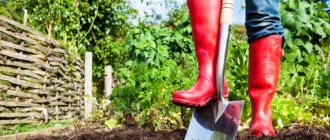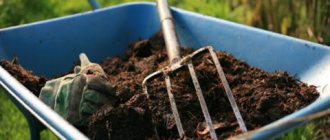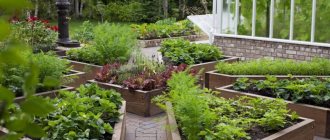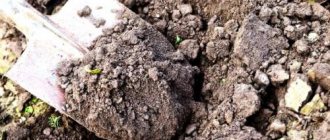After a busy summer season, I want to relax as soon as possible and, if possible, reduce the list of work. One of them - digging up the earth in the fall - was until recently carried out by all gardeners and was considered very important.
And now the question increasingly arises: is this really a necessary procedure, is it worth spending time and effort on it, or can you get by with just spring digging? So, let's finally find out whether it is necessary to dig up the garden in the fall and understand all the intricacies of this work.
Preparing beds in the fall for the new season is one of the most important conditions for obtaining a rich harvest. Over the winter, the soil is saturated with minerals that were added during digging. Snow saturates the beds with moisture faster, while the dug-up soil itself does not become compacted. As a result, in the spring it is much easier to carry out preparatory work before planting. Significantly save energy and time. But that’s not all the advantages of digging!
Why dig up the soil in the garden - the advantages of the procedure
ecololink.com
Have summer residents really made a mistake for decades when they started digging with a shovel in the fall? To be fair, it doesn't. Digging has many advantages, some of which are quite obvious, while others are not so noticeable, but also make their useful contribution. So, digging is useful because:
- during work it is easier to apply the necessary mineral and organic fertilizers, to deoxidize the soil, the effect of these procedures will increase many times;
- weeds will not have a chance to have a free winter, and their seeds will not have a chance to develop further, due to the fact that they will be deep in the soil;
- garden pests and their larvae, pathogenic bacteria, once on the surface, quickly die from cold, wind or exposure to chemicals, and birds are not averse to feasting on insects;
- the soil becomes looser, water- and air-permeable, is more easily saturated with moisture during the winter and does not become too compacted, and warms up faster in the spring;
- it becomes possible to clear the area of weeds, leaves, stones and other debris, which creates many problems in the spring.
As you can see, digging is important and brings many benefits. But where there are pros, there will always be cons.
It's not time to rest
The summer season is very exhausting even for experienced gardeners. Therefore, after its completion, you want to relax rather than engage in preparatory work. Many gardeners believe that digging up the soil in the garden in the fall is not necessary. For them it's just a waste of time. Is it really so?
Until recently, gardeners considered digging to be the most important preparatory procedure. It was traditionally done in both spring and autumn. But today, gardeners are increasingly digging up the soil only before planting crops.
During the winter, the soil changes greatly. During this time, it is saturated with a large amount of minerals. And the snow helps it absorb moisture. Therefore, it is important to prepare the soil for winter. Proper autumn digging will help make it more fertile. Accordingly, you will get a good harvest in the new season.
Autumn digging of soil has not only advantages, but also disadvantages. We'll tell you more about them below.
Is it necessary to dig up the soil in the fall in the garden - the disadvantages of digging
Now let’s look at the disadvantages of digging up the soil, and why adherents of organic farming dislike it so much.
Soil is a home for many living organisms, and each of them has its own place in this “kingdom”. When digging, not only harmful inhabitants appear on the surface, but also useful ones, those thanks to which the soil maintains its fertility. By depriving the beds of “good” bacteria and insects, we thereby impoverish the soil. But restoring soil fertility, alas, is not easy.
There is also a possibility that the weed seeds will still survive under the soil layer and safely overwinter until spring. In addition, with deep and frequent digging, a less nutritious layer of soil rises to the surface, the structure of the soil is disrupted, and it loses its physical properties.
And finally, digging is hard work, which has a bad effect on the back, heart and overall health if the summer resident is not very physically prepared. Mechanized digging also requires significant effort and preparation.
When and how best to plow the land: rules and advice
In this article you will find useful tips on when is the best time to plow the land and in what way.
Plowing of the land in large areas is carried out in spring and autumn. Before embarking on such an important event, it is necessary to understand its essence in detail. There is a common belief that plowing helps reduce the number of pests and weeds on the site. Also, agricultural workers prefer to plow the land in order to fertilize it.
The above opinions are certainly true, but they are far from the only ones. Among the key reasons for plowing a plot of land are:
- excessive soil compaction or erosion;
- presence of pests and weeds;
- salinization
The last reason is the most common. If you do not plow the soil periodically, salt will accumulate inside the soil. This is especially familiar to residents of regions with high humidity. Excessive salinity negatively affects crop yields.
Additionally, you should know that the loosening process leads to the saturation of the soil with oxygen. This process is important primarily for beneficial microorganisms. They have a direct impact on soil fertility indicators.
Optimal time for plowing
Experienced agronomists recommend plowing the garden once or twice a year. As noted above, spring and autumn are optimal for this. It is necessary to understand that the time of year also leaves its mark on the described process.
Autumn plowing of the site deserves increased attention. It is at this time that the land is being prepared for the next harvest year. Saturation of the soil with oxygen causes many weeds to die off. Closer to spring, a natural restoration of beneficial bacteria occurs, which has a great effect on the fertility of the soil.
When do you really need to dig up your garden?
As you can see, there are quite a few pros and cons to digging. But in reality, it all depends on two factors: the type of soil on the site and the climate in your region. In other words, the disadvantages will clearly manifest themselves if you dig where it is not needed at all, and vice versa.
If the soil on the site is heavy, clayey and uncultivated, then digging in the fall is highly desirable. But loose and light soils can simply be loosened. Sandy soil only needs spring treatment.
In regions with a hot climate, the soil is drier and does not require frequent digging, but in humid and cold areas of the country this procedure is necessary because... Under the influence of natural conditions, the soil becomes compacted and becomes unsuitable for growing cultivated plants. And although adherents of organic farming often cite the example of forest ecosystems, where everything grows on its own without digging and fertilizers, we should not forget that varietal and hybrid vegetables are unable to survive in such conditions. In other words, to obtain a harvest, certain conditions are needed, which are created on personal plots. Therefore, first of all, monitor the condition of the soil and plants.
The depth of digging depends on the planted crops
How to choose the right digging depth? You need to focus not only on your soil type, but on the type of crop that you are going to plant in the beds next year.
Experts advise sticking to the following depth:
- 25-30 cm (per spade blade) - for potatoes, beets, carrots, pumpkins, melons and parsley;
- 5-10 cm - for tomatoes, cucumbers, peppers, radishes and legumes.
It is advisable not to turn the soil layers over. This will help you retain more beneficial microflora. Be sure to remove weed roots and throw them away. If you bury them in the ground, there is a good chance they will survive the winter.
If the soil has not been dug up for several years, it is recommended to carry out two-tier digging. In this case, the layers of earth must be turned over.
When is the best time to dig up a vegetable garden - timing
We hope you are convinced that tillage in the fall is still necessary. But not every summer resident knows how and when to dig up a garden to get a positive effect. This should be done after harvesting, when late-ripening crops and all plant debris have been removed. It is advisable to carry out the work until the end of October - beginning of November, depending on weather conditions. You shouldn’t delay the work too much so that the first frost doesn’t set the soil. It’s ideal if you can finish digging before heavy rains.
Tools you'll need
To dig, you only need a shovel. You can also replace it with a pitchfork. These tools are the easiest way to dig up soil in small areas of up to 10 acres. A shovel is a budget option that copes well with any type of soil. But digging will require a lot of physical effort from the gardener. Forks sift the soil better and help achieve a finer soil structure. This is useful for young plants.
Of course, the easiest way is to use a cultivator to dig up the soil. But it's not cheap. Moreover, it does not always cope with dense soil. Therefore, you will have to dig up parts of the garden yourself.
Found a violation? Report content
When to dig potatoes
A certain amount of time must pass from the moment of planting to the moment of harvesting. And this time depends on several factors: the selected variety, time of planting, weather conditions. It is difficult to say the exact exact time.
There is some dependence on the harvest: if the potatoes were planted at the end of April, then they need to be dug up before the beginning of August. However, as statistics say, the favorable time for planting is the month of May and you need to dig up potatoes in early September. Although on average the harvest begins in mid-August.
The time it takes to dig up a vegetable directly depends on the variety. Early varieties are dug up 4-6 weeks earlier than late ones.
So, when digging up potatoes, you should know for what purpose the vegetable will be used. If you need young potatoes immediately for cooking, then you need to dig them up at the end of July.
If young potatoes are needed for cooking, then they need to be dug up at the end of July
If the root crop must be stored all winter, then early harvesting is not recommended. The peel should become rougher, otherwise the potatoes will quickly deteriorate and rot.
External signs of potato ripening
Potatoes are plants that are grown in large quantities relative to other crops. It is important not to miss the harvest time and dig up the root crop on time. It is important to be able to understand by external signs that a vegetable is ripe.
The main signs of potato ripening include:
- the bushes dry out, wither and turn yellow;
- the peel of dug up potatoes becomes coarser, becomes thicker and is difficult to peel off (unlike young potatoes);
- the tubers have accumulated enough starch to survive the winter for a long time. This is easy to find out; you need to drop iodine onto the pulp. If the flesh has turned lilac, then the potatoes are ready for storage;
- When harvested, the tubers are easily torn from the stems and roots.
Dry and yellowed tops are a sign of ripened potato tubers
Why harvest on time?
If you start digging up the plant ahead of time, the skins of the tubers are collected too well and can only be stored for a few months.
In order for the tubers to be preserved for a long time, the peel must harden. It is also impossible to keep vegetables in the ground for the following reasons:
- potatoes are damaged by harmful insects or diseases;
- tubers dry out and lose weight;
- fruits rot from wet soil;
- the vegetable is frozen due to the sudden onset of cold weather.
How can you plow the ground?
In order to plow the area, especially virgin land, it is recommended to install rotary plows on the walk-behind tractor. They are more massive, the design includes cutters, connection gears, and transport wheels. For greater stability on the ground, it is better to use metal wheels with hook elements.
Interesting materials:
How to care for tomato seedlings? How to care for eggplant seedlings? How to care for broccoli seedlings? How to care for strawberry seedlings? How to care for lavender seedlings? How to care for pepper seedlings? How to care for tomato seedlings in open ground? How to care for tomato seedlings in a greenhouse? How to care for tomato seedlings? How to care for tomato seedlings after germination?
Preparing the soil for plowing
To prepare the land for planting crops, you need to cultivate it well and saturate it with oxygen. This requires deep tillage of the soil so that the roots and tubers develop well.
There are several methods for preparing and cultivating land:
- deep using cultivators and flat cutters;
- plowing;
- with deepening of the arable horizon.
How to prepare the soil in spring
First of all, you should understand which soil is best for potatoes. Wet clay ones are completely unsuitable. Potatoes should not be planted in lowlands where there is a possibility of water accumulation.
The most suitable soil is light, sandy, loose. Ideal if it is black soil, peat soil. If the soil is oxidized, then before planting you need to treat it with wood pulp, sand with manure or compost.
If the soil is oxidized, it must be treated with wood ash
Plowing depth
The choice of treatment method depends on the land and geographical location. In almost all regions, fall plowing to a depth of 30 cm is suitable.
Do not plow deeper, as this can lead to severe oxidation of the soil.
How to treat the soil before planting
The first step to getting a rich harvest is to enrich the soil with oxygen. Therefore, it must be loosened. Loosening is carried out in dry weather. To do this, you need to dig the soil to a depth of 15 cm.
Before planting potatoes, you need to carry out a number of procedures:
- dig up the soil to a depth of 15-20 cm in advance to destroy pests;
- treat the soil with special solutions to prevent late blight;
- enrich the soil with minerals and organic matter;
- a year before the planned planting of potatoes, plant green manure on the plot.
Loosening is done to enrich the soil with oxygen.
How to dig potatoes
There are several ways to dig up potatoes. To do this, they often use either ordinary gardening tools - a shovel or a pitchfork, or special agricultural equipment.
At the same time, digging by hand is a rather labor-intensive process, especially for those who have health problems. To cultivate large areas, it is better to use a walk-behind tractor.
Digging by hand is a very labor-intensive process.
Motoblock
Harvesting with agricultural equipment can be carried out after all the tops on the site have been cut off. After 2-3 days, you can begin to dig up the root crop.
The equipment is prepared in advance. To do this, it is recommended to pay attention to the rotation elements. They need to be thoroughly lubricated with special oil, and the parts of the walk-behind tractor that will loosen the soil should be cleaned of soil, clay, and stones.
If the blades become dull, they must first be sharpened.
Using a walk-behind tractor or digging with a walk-behind cultivator requires following the instructions:
- shrubs should be planted in advance in one even row so that equipment does not have to be maneuvered throughout the entire area;
- the distance between the rows should be 70-80 cm so that the walk-behind tractor does not damage the neighboring ridge with its wheels;
- when harvesting, it is better to use additional attachments to regulate the depth;
- you need to adjust the equipment in advance so that it digs easily;
- In order for the wheels of the walk-behind tractor to move evenly, it is recommended to dig up potatoes through a ridge.
Manually
You can dig potatoes manually with a shovel or a digger. However, such work is suitable for no more than 5 acres of land. If the garden is larger, it is better to use technology - it is faster and more practical. Manual digging of potatoes is done as follows:
- one person digs under a tuber. To do this, you need to drive a shovel near the tuber and lift it to the surface;
- the second person collects potatoes, walking behind.
With manual labor, you can do two things at once - collect potatoes and sort them. You can leave the tubers to dry on the surface of the rows.
Before harvesting, it is recommended to prepare the place where the potatoes will be harvested. When picking a vegetable, it is recommended not to drop it to avoid damage.
Manual digging of potatoes is done with a shovel or pitchfork
It’s more convenient when one person digs up the potatoes, and the second takes them out of the ground and sorts them
Which method to choose for plowing: manual or mechanical?
Many inexperienced gardeners ask this question. There are many methods and devices. answering the question of when to plow the land, the question arose of “what” to plow. Of course, many will say that you need to dig with a plow. We mainly use three types: shovel, walk-behind tractor and tractor. Each has its own advantages and disadvantages.
A shovel is cheap and cheerful. But you definitely won’t damage the fertile layer. But more often than not, this method will not give much results. You can plow with a shovel if you have a very small garden.
If you have at least 5 acres, then a walk-behind tractor is ideal. They can plow quite deep - up to 25 cm. This will saturate the soil well with oxygen and remove a lot of weeds. They can also plow up all the passages of rodents. Then they will not harm you the next time you land.
But if you have large gardens, then in any case you need a tractor. It is desirable that a person not only knows how, but also knows how to plow the land correctly. The properties of the soil determine which type of tractor is best to use. Some heavy tractors may simply not reach deep into the ground. They may sink into the ground and not really plow.
That's all for me, I think this article was useful to you, share it on social networks, write comments, bye everyone.
- Author: Maria Sukhorukikh
Rate this article:
- 5
- 4
- 3
- 2
- 1
(0 votes, average: 0 out of 5)
Share with your friends!
Dependence on soil type
However, you should not go to extremes, because whether the soil needs deep digging in the fall depends primarily on its type. with clayey or loamy heavy soil, where groundwater lies close to the surface,
cannot do without autumn cultivation The fact is that all the pores and holes formed during digging in the fall are filled with air. And the treated soil increases its volume almost 2 times. In loose soil, due to carbon dioxide and oxygen, plant residues decompose faster and humus is formed. In such soil, plants tolerate frost and drought more easily, and their roots penetrate deeper into the soil.
But initially light and loose, sandy and humus-rich soils are advised to simply be deeply loosened in the fall. On a site with such soil, it is recommended to dig up only heavily polluted areas, removing weed roots. Frequent and deep digging of such soil is not useful. This can destroy the soil structure.
Tilling the land in the fall is best done before the onset of cold weather and before the snow falls. Because if you bury it in the ground, it will slow down the warming of the soil in the spring. And, most importantly, do it in time before the period of prolonged rains, otherwise you can achieve the effect of compacting the earth.
Spring plowing
In the spring, the garden is also plowed. During this period, soil reservation is carried out. This work takes place immediately after the top layer of soil has dried sufficiently. For plowing large gardens, it is better to use a tractor cutter. At the same time, it is not at all necessary to plant it deeply. In this case, the soil is loosened safely, because all its beneficial bacteria remain absolutely unharmed.
Regardless of the time of year, you should definitely know how to plow the land correctly and what secrets this process has. There are both manual and mechanical methods of plowing the garden. For small areas it is not necessary to call a tractor. In this case, a walk-behind tractor will be sufficient. The appropriate technology allows for fairly deep plowing (up to 25 cm).
A tractor is necessary for large vegetable gardens. At the same time, the person who will manage it must have professionalism and appropriate experience. When choosing the type of tractor, it is necessary to take into account the properties of the soil itself. Sometimes the heaviest equipment simply cannot penetrate deep into the ground. Such tractors even sometimes sink in the soil, which is why plowing is not done properly.











